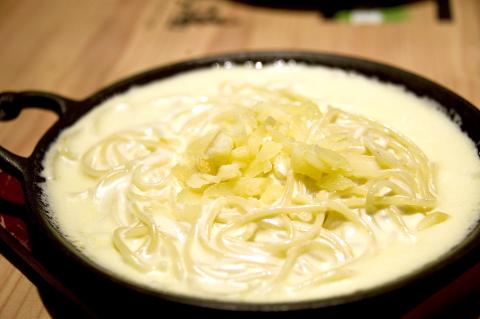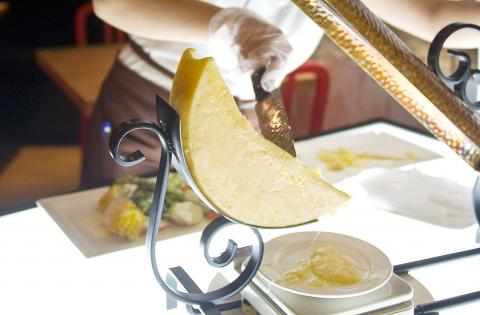A half-rind of legendary Raclette cheese sits on a table In Hanabatake Ranch, the latest Japanese import to Taiwan launched in June at ATT4Fun. When someone orders a dish that contains the Hokkaido-based ranch’s signature product, a server turns on the metallic heat lamp and slices off generous globs directly onto the plate as the gooey goodness melts.
Run by Japanese TV host and celebrity Tanaka Yoshitake, the ranch’s Raclette was named Japan’s best cheese in 2011 at the All Japan Natural Cheese Contest. The variety has its origins in Switzerland and is used mostly as a melting cheese. The way it is served at the restaurant harkens back to the old days where Swiss cow herders would place the cheese next to the campfire and scrape off the softened parts to spread on bread or potatoes.
It’s a pleasant atmosphere with a polite and helpful staff, modern and colorful with a touch of Japanese cuteness (fairytale-like houses and animal decorations). The storefront sells a variety of snacks from the ranch, including milk chocolate potato chips and strawberry candy.

Photo: Han Cheung, Taipei Times
The menu is typical Japanese-style Western food, with burgers, pastas, pizzas, steak and the like. The “must-order” item here is the triple cheese pasta (NT$260), which is plain spaghetti in a Camembert and Gouda cheese sauce topped with the Raclette — and nothing else. Don’t spend too much time taking pictures of your food here — the cheese hardens quickly.
For starters, we ordered the Raclette warm salad (NT$280), which consisted of sliced carrots, potatoes, asparagus, broccoli and corn, drizzled with cream sauce and topped with thick, melted slices of Raclette. It’s probably a fancier variation of what the Swiss cow herders ate around the campfire.
The cheese has a strong creamy aroma that can be sensed from several feet away. It melts at a similar consistency with Provolone, but the taste falls on the sharper and saltier side, flavorful but not too pungent. It’s a balanced product that is enjoyable, but not especially memorable. It complements the sweeter and milder sauce well.

Photo: Han Cheung, Taipei Times
The vegetables were simply boiled without flavor, and were a bit too soggy, the water mixing with the cheese when taking a bite. Maybe roasting them would have been a better idea.
Each main dish comes with a set meal at an additional charge. The basic set (NT$120) consists of bread, soup and a drink. The deluxe set (NT$180) is the same as the basic set plus a dessert under NT$120. As the vegetable soup and bread did not stand out, one may be better off ordering the desserts a la carte — as the ranch is also famous for its sweets.
The triple cheese pasta also filled the air with a rich, mouth-watering aroma upon arrival. The noodles are first cooked in the Camembert, then the Gouda is added. The sauce is rich and fondue-like with a bit of Japanese dairy product-style sweetness that balances out the sharper Raclette, which gradually melts into a soft stringiness that works well with the thinner sauce. The lack of toppings makes the dish a bit monotonous, though, and perhaps they could offer the customer some options (for the last few bites I took my friend’s diced bell peppers).

Photo: Han Cheung, Taipei Times
If you are sharing food, for the third dish you probably should order something that’s not creamy and without the cheese, as all the dairy is getting too much at this point. A burger (between NT$260 and NT$320) or Hokkaido pork rice bowl (NT$180) would be a good choice.
However, with our minds full of cheese when we walked in, we ordered the cream risotto (NT$240) instead, which came with okra and diced bell peppers. The sauce is milder than the previous pasta, but still flavorful, although the rice was slightly undercooked. The okra’s sliminess meshes surprisingly well with the rice and crunchy peppers, and the meat is tender but flavorless.
After all the richness, the Hokkaido egg tart (NT$120 a la carte) was pleasantly not too sweet, and its consistency right between fluffy and chewy. Paired with a crisp and flaky crust, it made a fitting ending to the meal. The plate comes with caramel sauce if you prefer it sweeter.

Photo: Han Cheung, Taipei Times
Like the cheese, the experience as a whole was maybe too well-balanced — enjoyable, but somehow just not very memorable.

May 11 to May 18 The original Taichung Railway Station was long thought to have been completely razed. Opening on May 15, 1905, the one-story wooden structure soon outgrew its purpose and was replaced in 1917 by a grandiose, Western-style station. During construction on the third-generation station in 2017, workers discovered the service pit for the original station’s locomotive depot. A year later, a small wooden building on site was determined by historians to be the first stationmaster’s office, built around 1908. With these findings, the Taichung Railway Station Cultural Park now boasts that it has

Wooden houses wedged between concrete, crumbling brick facades with roofs gaping to the sky, and tiled art deco buildings down narrow alleyways: Taichung Central District’s (中區) aging architecture reveals both the allure and reality of the old downtown. From Indigenous settlement to capital under Qing Dynasty rule through to Japanese colonization, Taichung’s Central District holds a long and layered history. The bygone beauty of its streets once earned it the nickname “Little Kyoto.” Since the late eighties, however, the shifting of economic and government centers westward signaled a gradual decline in the area’s evolving fortunes. With the regeneration of the once

The latest Formosa poll released at the end of last month shows confidence in President William Lai (賴清德) plunged 8.1 percent, while satisfaction with the Lai administration fared worse with a drop of 8.5 percent. Those lacking confidence in Lai jumped by 6 percent and dissatisfaction in his administration spiked up 6.7 percent. Confidence in Lai is still strong at 48.6 percent, compared to 43 percent lacking confidence — but this is his worst result overall since he took office. For the first time, dissatisfaction with his administration surpassed satisfaction, 47.3 to 47.1 percent. Though statistically a tie, for most

In February of this year the Taipei Times reported on the visit of Lienchiang County Commissioner Wang Chung-ming (王忠銘) of the Chinese Nationalist Party (KMT) and a delegation to a lantern festival in Fuzhou’s Mawei District in Fujian Province. “Today, Mawei and Matsu jointly marked the lantern festival,” Wang was quoted as saying, adding that both sides “being of one people,” is a cause for joy. Wang was passing around a common claim of officials of the People’s Republic of China (PRC) and the PRC’s allies and supporters in Taiwan — KMT and the Taiwan People’s Party — and elsewhere: Taiwan and